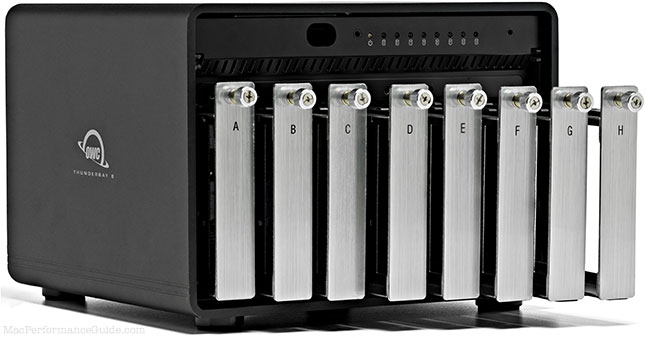
|

|

|

$220 SAVE $130 = 37.0% Western Digital 16.0TB Western Digital Ultrastar DC HC550 3.5-in… in Storage: Hard Drives
|

|

|

|

|
Anker Solar Panels: 15W PowerPort Solar Lite, 21W PowerPort Solar
Related: Apple iOS, Apple iPhone and iPad, flashlight, gear, GPS, iOS, laptop, MacBook, power, USB
See Anker Power Port Solar Panel @AMAZON at Amazon.com. Please buy through these links at Amazon.
Two solar panels are covered here:
- Anker Power Port Solar Lite 15W Solar Panel solar panel, 361g. About $49 @AMAZON.
- Anker PowerPort Solar 21W Solar Panel solar panel, 478g. About $59 @AMAZON.
There is no meaningful size difference between the two as both fold to identical length and width. While the PowerPort Solar is a little thicker when folded, the hard plastic USB connector dongle inside both of them effectively makes both panels effectively identical for stowage, backpacking, etc. The quoted thickness is misleading; most of the panel is much thinner. It’s that hard plastic USB connector dongle that is the only thick part when folded.
Hence for a little more weight and a few millimeters more folded thickness, the PowerPort Solar (non-“Lite”) delivers 42% more power for a 32% gain in weight.
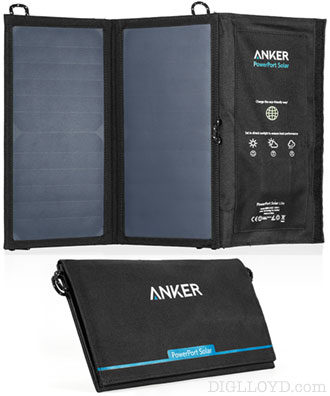
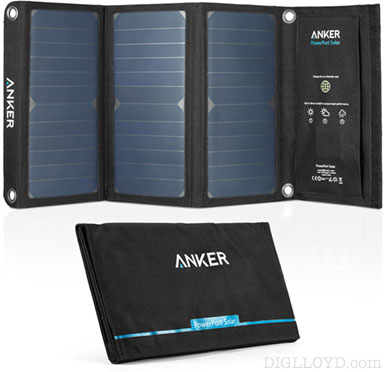
PowerPort Solar Lite 15W Solar Panel
| PowerPort Solar Lite | PowerPort Solar | |
| Output: | DC 5V 2.1A | DC 5V 3.0A |
| Weight as actually weighed: Exclusive of USB cables needed for charging devices |
361g | 478g +117g / +32% |
| Folded size: | 11.0 × 6.3 × 0.7in / 280 × 160 × 19 mm bi-fold panel design |
11.1 × 6.3 × 1.1 in / 282 × 160 × 28 mm tri-fold panel design |
| Opened size: | 18.1 × 11.0 × 0.2in / 460 × 2 80 × 4 mm | 26.4 × 11.1 × 0.2 in / 670 × 282 × 5 mm |
| Notes: | 2 panels cloth loops for hanging or tie-down |
3 panels metal grommets for hanging or tie-down |
| Street price: | about $42 @AMAZON | about $60 @AMAZON |
21W = a lot more juice than 15W
The PowerPort Solar is a 3-panel tri-fold design versus a 2-panel bi-fold design for the PowerPort Solar lite. For another 117 grams, the triple panel design delivers up to 3 amps of charging power, versus 2.1 amps. Both figures are peak potential and mainly for giggles; actual power output is almost always lower (time of year, angle of sun, cloud cover, etc).
The extra amperage is a BIG DEAL when the sun is weak, such as with partial clouds, late in the year or winter and so on, because it may allow a charge when the Lite panel cannot provide sufficient oomph to charge at all. It also means that charging is substantially faster, particularly if charging something like the Anker PowerCore+ 21000 battery (see charging tests).
Users looking to cut weight to the bone should go with the 15W Lite panel; it is more than adequate to charge an iPhone and a flashlight. But the smart move if 117g weight savings is not a requirement is to get the 21W panel for its faster charging and improved ability to charge under marginal lighting conditions. When time constraints or conditions deliver only enough sunlight for charging one item, will it be the phone or the flashlight or the camera? The 21W panel increases the odds that 2 or 3 items get juice, instead of 1 or 2.
Efficiency
Anker claims solar output efficiency that is as much as 50% higher than other brands. Anker also claims “smarts” in charging devices as fast as possible.
The electronic gear to test this claim was not available (and would have required a whole suite of competing products), but charging rate seemed impressive with a variety of gear—see the tests that follow.
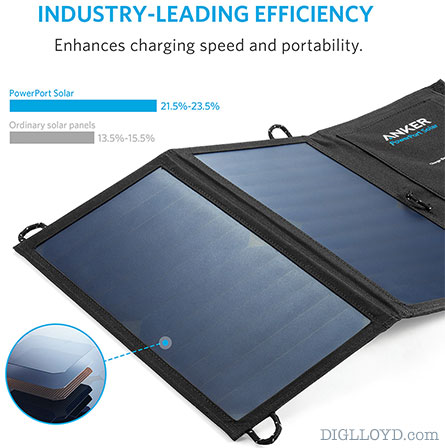
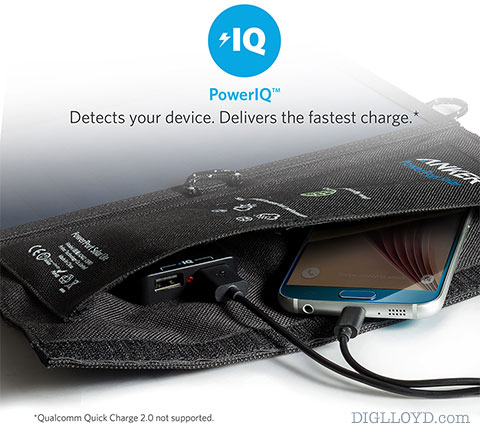
Compared to GOAL ZERO Nomad panels
The Anker Power Port Solar Lite is both smaller and much lighter and about 1/4 the price @AMAZON of the GOAL ZERO Nomad 20 Solar Panel and thus highly portable. At about 3/4 pound, the weight of the Anker panel weight may dissuade weight conscious backpackers versus the GOAL Zero 7W solar panel, but for trips of 5+ days, it may be indispensable.
At about $42 @AMAZON, the 15W Anker Power Port Solar Lite is 1/3 the weight and about 1/4 the price of the GOAL ZERO Nomad 20 Solar Panel @AMAZON, and thus a huge value. The 21W Anker PowerPort Solar is only modestly more at about $59 @AMAZON. While the Anker Power Port Solar Lite has nominally lower output than the 20W Goal Zero, (15W vs 20W), claimed efficiency could eliminate that gap. Testing suggest the two are actually similarly capable in spite of the nominal 5W difference.
Even if the Anker Power Port Solar Lite falls a bit short of the GOAL ZERO Nomad 20, the Anker PowerPort Solar is a higher output sibling weighing 417 grams (half the weight of the Nomad 20). The 21W Anker PowerPort Solar is about 1/3 the price @AMAZON of the Nomad 20, so it too offers huge value at about $59 @AMAZON.The Power Port Solar rated for a 3 amp output vs 2.1 amps for the Lite version, but at a weight cost of only 417g vs 355g—42% more output for 17% more weight. That amperage difference is very important if charging more than one device at a time, or in marginal conditions.
Usage scenarios
Both panels are suitable for directly charging small electronics and/or small batteries. Two USB ports allow directly plugging in any USB device for charging:
- iPhone and other phones
- USB-Rechargeable flashlights like the Fenix RC11 @AMAZON.
- Bike tail lights like the Lupine Rotlicht Tail-Light.
- Lupine LED headlamp and bike lights such as Lupine lighting using the Lupine USB charger.
- Anker PowerCore batteries (Anker calls these “portable chargers”).
My interest is in off-the-grid usage: could the Anker PowerPort solar panels recharge key items in reasonable time, like camera, flashlight and iPhone? Key electronics are items are a camera and a flashlight and an iPhone, for iPhone panoramas. A handheld GPS does not make my list, but it might for some people (some brands/models of GPS units have USB charging and some do not).
For short outings, carrying extra camera batteries or something like the very nicely designed and inexpensive Anker PowerCore batteries of various capacities @AMAZON makes more sense. The Anker PowerCore 20100 @AMAZON can even power a MacBook.
Eight-bay Thunderbolt 3 high-performance storage for photo and video.
Hard drives or SSDs.
Non-RAID or RAID-0/1/4/5/10.
Capacities up to 144 Terabytes!
Charging tests
Watt hours(Wh) describe the energy content regardless of voltage and amperage. Batteries may have different voltages (V) and capacities (mAh), but watt hours gives the energy content.
For perspective:
- Sony NP-FW50 battery for the Sony A7R II is 7.3 Wh
- Nikon EN-EL15 battery for the Nikon D810 is 14 Wh.
- Fenix RC11 flashlight can take 2600 mAH / 9.36 Wh or 3500 mAh / 12.6 Wh battery
- iPhone 6s Plus uses internal 11 Wh battery.
Real world testing shows that results are affected by a number of factors:
- The rated amperage is for giggles only. Not going to happen, even at noon on the summer solstice. Figure at best about 2/3 the rated capacity, and over the course of the day, 1/2, e.g., mean of 10 watts for a 21W panel.
- Charge rate is often constrained by the device itself. For example, the Fenix flashlights and external charger do not accept more than 1.5 amps @ 5V.
- Average watt hours actually stored is realistically not more than 5 to 7 Wh per hours. So a 74 watt-hour battery will take at least 10 hours under optimal conditions.
- When a device like a camera or phone reaches a mostly-charged state (say 80%), attaching a battery to soak up additional power may be more efficient (charge both at once).
- When charging two devices at once, total charge time is likely fastest with both charging simultaneously, but one device might still charge at nearly full rate (see the combo charge for PowerCore 20100+ and RC11)
* Charging conditions unless noted: full sun in early August, 500' elevation, latitude 37°N, 70° to 90°F, battery pack kept shaded. Times not exact, but reasonably close.
Summary of charge times:
| 15W PowerPort Solar Lite | 21W PowerPort Solar | Comments | |
|---|---|---|---|
| iPhone 5s | 20% to 100% in just over 2 hours | ||
| iPhone 6s Plus discharged to self shut-off. 11 Wh |
0% to 70% @ 65 minutes 0% to 97% @ 110 minutes 0% to 98% @ 120 minutes 0% to 100% @ 127 minutes or less |
theoretical best = 62 minutes @ 5V / 2.1A (not verified as possible) | |
| Charge Sony A7R II battery in-camera 7.3 Wh, totally drained |
2 hours 11:00 - 13:00 |
just as fast as powered USB | |
| Fenix RC11 flashlight 2600 mAH / 9.36 Wh battery |
4 hours 11:00 - 15:00 |
just as fast as powered USB | |
| Fenix RC09 flashlight two (2) X 700 mAh / 2.59 Wh, consecutively |
3.5 hours 9:00 - 12:30 |
Flashlight accepts at most 1.5 amps | |
| Fenix 3500 mAH / 9.36 Wh battery in Fenix charger | 5 hours 12:00 - 5:00 |
Nearly as fast as USB. Charger limited to 1.5 amps |
|
| Anker PowerCore 20100+ 74 Wh battery + Fenix 3500 mAH / 12.6 Wh battery in RC11 flashlight |
15 hours ~= 11 hours full sun day 1: 08:00 - 13:00 battery done day 1: 08:00 - 20:00 PowerCore @ 70% done day 2: 09:00 - 12:00 PowerCore @ 1005 |
day 1 8:00 AM foggy overcast, sunny by 9 AM TOTAL of 86.6 Wh |
Charging the iPhone 6s Plus and iPhone 5s
In mid-day sun, an iPhone 5s charged from 20% to 100% in just over 2 hours using the 15W PowerPort Solar Lite.
In mid-day sun with the 21W PowerPort Solar, a totally drained iPhone 6s Plus charged from 0% to 97% in 110 minutes. This is effectively full charge; even on desktop USB the iPhone 6s Plus tends to read 98% for a long time. It took 65 minutes to get to 70% charge.
Charging the Fenix RC11 and Fenix RC09 flashlights
Note that charging power for the RC11 and RC09 flashlights is limited to 1.5 amps @ 5V, so that charge time may actually be constrained not by the solar panel, but by the charging limits of the device.
First, the Fenix RC11 @AMAZON was run down on Turbo mode (with a fan to cool it) until it eventually dimmed itself to the2nd lowest power level.
The Fenix RC11 uses a 2600 mAh battery (3.6V, 9.36 Wh), a fairly substantial amount of power.
The Fenix RC11 it was connected to the PowerPort Solar Lite at about 11:00 AM. By about 3:00 PM the flashlight was fully recharged.
Similarly, the PowerPort Solar Lite was able to charge two drained 700 mAh / 2.59 Wh batteries in 3.5 hours of strong sunlight. It also charged a Fenix 3500 mAh 18650 battery(12.6 Wh) in a standalone charger in about 5 hours. That charger limits max input to 1.5 amps @ 5V, and even on USB the charge time for the 18650 battery is 4 hours. So this is an impressive performance almost as good as a powered USB hub.
As another test, the Fenix RC11 with a 3500 mAh battery PLUS the Anker PowerCore 20100 were both connected simultaneously to the Anker PowerPort Solar on a foggy morning at 8 AM (both were fully drained). That’s a total charging load of 86 watt hours! The sun broke through at 9 AM, and by 13:00, the RC11 3500 mAH battery was full charged. The PowerCore 20100 reached 70% full by the end of the day, and by noon the next day was 100% charged. That’s 86 watt hours of charge achieved in 15 hours of charging, with only 12 of those hours in good full sun.
* Charging conditions: full sun in early August, 500' elevation, latitude 37°N, 80° to 90°F, battery pack kept shaded.
Charging the Anker PowerCore 20100 LiIon battery
The Anker PowerCore+ 20100 USB-C battery is a 20100 mAh / 74 Wh LiIon battery specified to be able to fully charge an iPhone about 7 times, and to be capable of charging the Apple MacBook at 5V/2.4A. Anker makes various other capacity batteries (smaller and larger).
The output from the Anker Power Port Solar Lite 15W Solar Panel cannot be expected to fully charge the Anker PowerCore+ 20100 battery in one day given the high battery capacity; the rated amperage just is not achievable over the course of the day, if at all under anything but crystal clear skies at the summer solstice. But two days should suffice for a nearly full charge, and the Anker Power Port Solar charges faster than that.
My scenario is that when out and about I carry my gear with me and have no time to let a solar panel do its thing. Hanging the panel on the back of a pack can be done, but it’s pointless if facing towards the sun or if in the shade, and it’s a nuisance for getting to things. So
Inquiries to Anker were adamant about this point of needing two days to charge. But to the “field use” scenarios it is beside the point: for base camp scenarios, leaving the solar panel charging the Anker PowerCore battery is my goal—collect those energy packets from the sun while out and about. That it “only” raises the charge level from, say, 20% to 60% is just fine—it’s “juice” that can recharge the camera/iPhone/flashlight that night—juice that otherwise would have gone uncollected.
Testing with the PowerPort Solar Lite from about 1:00 PM to 7:00 PM* showed a gain from 4 bars to 8 bars on the PowerCore+ 20100—quite significant and hardly optimal for charging, being past the ideal hours. The next day a full charge was achieved from about 9:00 to 1:00. So it seems that two full days should fully charge the PowerCore+ 20100 battery with the PowerPort Solar Lite. Using the PowerPort Solar should result in very meaningful reductions such that somewhere around 60% capacity should be captured in one day.
Testing with the PowerPort Solar: the Fenix RC11 with a 3500 mAh battery PLUS the Anker PowerCore 20100 were both connected simultaneously to the Anker PowerPort Solar on a foggy morning at 8 AM (both were fully drained). That’s a total charging load of 86 watt hours! The sun broke through at 9 AM, and by 13:00, the RC11 3500 mAH battery was full charged. The PowerCore 20100 reached 70% full by the end of the day, and by noon the next day was 100% charged. That’s 86 watt hours of charge achieved in 15 hours of charging, with only 12 of those hours in good full sun. We can thus deduce an average charge rate of about 5.7 watt hours per hour over a long day’s sunlight including marginal conditions. That’s equal to 1.1 amps on average—a far cry from the rated 3.0 amps. Even if reduced to 11 hours for fairness, that’s still only 86/11 = 1.56 amps average. Still barely more than half claimed. While I’m pleased with the performance, the numbers certainly seem misleading vis a vis actual achievable wattage.
* Charging conditions: full sun in early August, 500' elevation, latitude 37°N, 80° to 90°F, battery pack kept shaded.
Seagate 22TB IronWolf Pro 7200 rpm SATA III 3.5" Internal NAS HDD (CMR)
SAVE $100
















